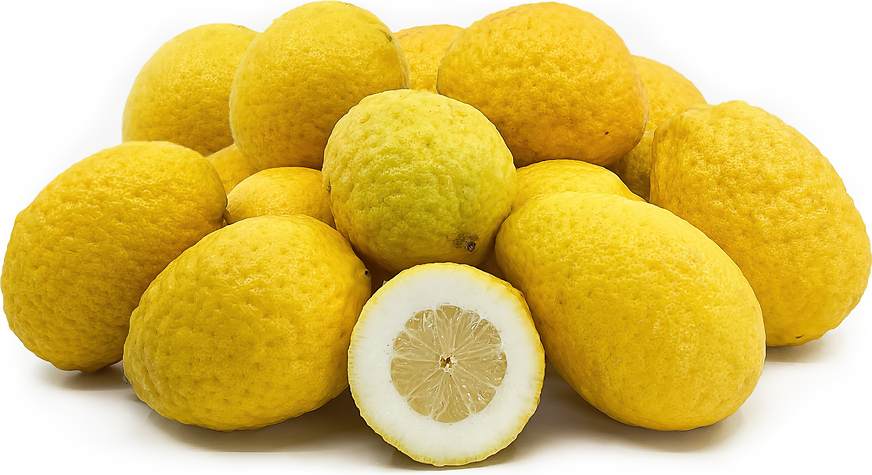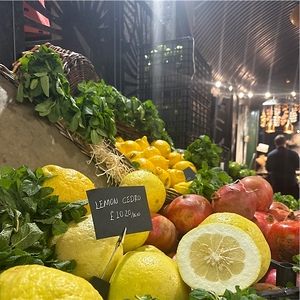


Young Sicilian Cedro
Estimated Inventory, lb : 0
Description/Taste
Young Sicilian cedro is small in size compared to other cedros that can grow to be the size of footballs, but it is still larger than other citrus varieties, such as standard lemons. The fruits average 10 to 15 centimeters in length and 7 to 9 centimeters in diameter and have an elongated, oval shape with tapered ends. It is important to note that the fruit's size and shape are variable, depending on cultivation and the age of the fruit during harvest. Young Sicilian cedro showcases smooth and glossy, lightly textured and pebbled, to bumpy skin, and the surface is covered in prominent oil glands that sometimes make the skin feel sticky or oily. These oils contained within the pores are aromatic and highly fragrant, with the ability to fill a room with its scent. The skin also ripens from green to shades of bright, golden yellow. Underneath the surface, a thick layer of white pith, also known as the albedo, encases a small central cavity filled with flesh. The pith is spongy, moist, soft, chewy, and cottony, and the flesh is tender, succulent, and lightly aqueous, divided into 7 to 8 sections by thin membranes. Some varieties of Young Sicilian cedro may have seeds, while others are seedless. Young Sicilian cedro is fragrant, releasing a permeating floral, bright, and zesty scent. The entire fruit is edible except for its seeds and ranges in flavor, depending on the variety, from sweet, floral, tangy, tart, mild, to bright.
Seasons/Availability
Young Sicilian cedro is available in the early winter through spring.
Current Facts
Young Sicilian cedro, botanically classified as Citrus medica, is a general descriptor for multiple Cedro varieties belonging to the Rutaceae family. Cedro is a type of citrus also known as Citron worldwide. The name Cedro is an Italian term used in local markets throughout Italy, and the species has been utilized as a culinary ingredient, medicinal remedy, and religious symbol for thousands of years. In Sicily, Cedro is found in varying sizes, and the name Young Sicilian cedro is mostly used to refer to the size of smaller fruits. Several varieties of Cedro are grown throughout Sicily, and these cultivars are either acidic and sweet-tart, non-acidic and sweet, or pulp-less. Some of the most cultivated varieties in Sicily include the Syracuse Cedro, Bajoura Cedro, Cedro of the Aeolian Islands, Diamante Cedro, and Trabia Cedro. Young Sicilian cedro is primarily utilized the same as larger varieties in culinary preparations but is valued for its smaller, more manageable size. The fruits have very little to no flesh and are savored for their edible, white pith, and aromatic nature. Young Sicilian cedro is used fresh or cooked, imparting a fragrant, citrusy fragrance into culinary preparations and specialty beverages.
Nutritional Value
Young Sicilian cedro has not been extensively studied for its nutritional properties. Cedro, in general, is a source of vitamin C to strengthen the immune system, potassium to balance fluid levels within the body, vitamin A to maintain healthy organs, calcium to build strong bones and teeth, and fiber to regulate the digestive tract. Cedro also provides other nutrients, including magnesium, vitamin B6, iron, and zinc. In natural Sicilian medicines, Cedro was used as a hangover cure, insect repellant, and detoxifying element to cleanse the body. It was also made into a tea to reduce symptoms associated with colds and coughs. The volatile oils encased in the rind have also been extracted into essential oils for use in cosmetics, perfumes, haircare, and body care products. One element in the oil, known as limonene, is believed to have antimicrobial and antioxidant-like properties to protect the cells against the damage caused by oxidative stress and free radicals.
Applications
Young Sicilian cedro has a sweet, tangy, floral, and citrusy flavor suited for fresh or cooked preparations. Smaller cedros can be used in any preparation calling for Cedro or Citron and will have the same preparation method. It is important to note that smaller Cedros may have minimal amounts of the sweet, white pith. Cedro is entirely edible from its rind, pith, and flesh; only the seeds are discarded. The fruit’s exterior should be washed before use as its bumpy nature may hold crevices filled with dirt. Once cleaned, Cedro can be thinly sliced and sprinkled with salt or sugar as a snack. It is customary in Sicily to serve slices of Cedro as an after-dinner palate cleanser or as an afternoon snack for kids. Cedro rind can also be zested, or the pith can be sliced or shaved into salads. The citrus adds a refreshing taste to green salads and herb salads, and the pith is often sprinkled in balsamic vinaigrette for enhanced flavoring. Shaved Cedro sprinkled in sugar is used as an accompaniment to panna gelato or mixed into the ingredients used to top toasted bread in bruschetta. In addition to fresh preparations, Cedro is popularly simmered into jams, jellies, marmalades, and syrups. These preserves are folded into fillings for pastries and baked goods, and Cedro marmalade is a choice spread for cheese platters and toast. Cedro extract is made to flavor cornetto, cookies, and cakes, and the peel is traditionally candied into a chewy treat. Candied Cedro is notably used in panettone, a sweet bread sometimes referred to as a cake served during Christmas celebrations in Sicily. Candied Cedro is also topped over cannoli, another famous dessert from Sicily. Beyond sweet preparations, Cedro adds bright flavors to savory dishes such as risotto. The fruit’s citrusy, lemon-like fragrance is combined with herbs to add complexity to risotto, or it is incorporated into seafood dishes. Cedro can also be blended into pasta sauces, especially pesto. In Italy, Cedro is used to flavor a fizzy beverage called cedrata soda. It is also used to make a variation of limoncello. Cedro pairs well with nuts such as almonds, walnuts, and pistachios, herbs including fennel, sage, mint, and basil, celery, arugula, tomatoes, capers, vanilla, maple syrup, and seafood such as crab, clams, and fish. Whole, unsliced Cedro will keep for 2 to 4 weeks when stored in a cool and dry place away from direct sunlight. In the refrigerator, the fruit will last for several months.
Ethnic/Cultural Info
Cedro is traditionally served in recipes during the Feast of Sant'Agata, also known as Agatha, the Patron Saint of Catania in Eastern Sicily. The annual celebration is held from February 3rd to 5th and honors the courage and religious devotion of Saint Agatha. Legend has it that Agatha was a young, beautiful woman who was part of an aristocratic family in Catania during the 3rd century CE. One day, Agatha was courted by the Roman Governor Quinziano. Agatha had no interest in the governor and wanted to remain devoted to God. Quinziano was furious with her rejection and had Agatha killed. It is said during her murder, her breasts were ripped from her body. After her death, the city of Catania later faced impending doom from a volcanic eruption of Mount Etna. Catania residents rushed to stop the lava flow and used a white veil spread over Agatha’s tomb. The veil turned red and miraculously stopped the molten liquid from damaging the city. Since this occurrence, Agatha was declared the Patron Saint of Catania and is honored each year with a feast. The Feast of Sant'Agata attracts thousands, sometimes millions of visitors, and participants take part in parades, religious ceremonies, firework displays, and social gatherings. During the feast, Cedro is customarily sliced and served lightly salted as a snack or candied and incorporated into a cassatine known as the Minne di Sant’Agata. The small cakes are made into half-moon shapes and are constructed to resemble the shape of a woman’s breast. Cedro is infused into the ricotta cheese filling, and the cakes symbolize courage, devotion, and gratitude. It is a superstition that the cakes should always be eaten in pairs to honor the desserts representing a piece of Saint Agatha.
Geography/History
Cedro, more commonly known worldwide as Citron or Citrus medica, is native to the central Himalayan foothills and has been growing wild since ancient times. Citron is considered one of the four original citrus varieties and was first domesticated in its native region. Over time, the species was carried with traveling merchants and was initially utilized as a medicinal ingredient. Citron was eventually introduced to Western Asia, the Middle East, and the Mediterranean, later being planted in Greece. Theophrastus of Eresus, a Greek philosopher, documented Citron in his book Historia Plantarum in the 4th century BCE. Theophrastus mentions that Citron was not considered an edible fruit and was primarily sourced for its fragrant oil. Citron was not recorded in written works as an edible fruit until it was noted in Greek philosopher Plutarch’s work Quaestiones Convivales. Citron was found in Italy sometime around the 3rd century BCE and was mainly planted along Italy's western coast, especially in Calabria, the Amalfi Coast, and Sorrento, and on the island of Sicily. In Italy, Citron was called Cedro, and the species was believed to be one of the first types of citruses grown in Sicily, featured in mosaics inside the Villa di Casale Piazza Armerina, a famous estate near Enna in Central Sicily. Since its introduction, Cedro has remained a signature citrus of Sicily and is grown in commercial orchards and home gardens for culinary, medicinal, and cultural uses. In the early 20th century, Cedro was industrially cultivated and processed into candies with the development of sugar refinement for export to other countries. Today, Young Sicilian cedro is cultivated across Sicily and sold fresh through local markets.








